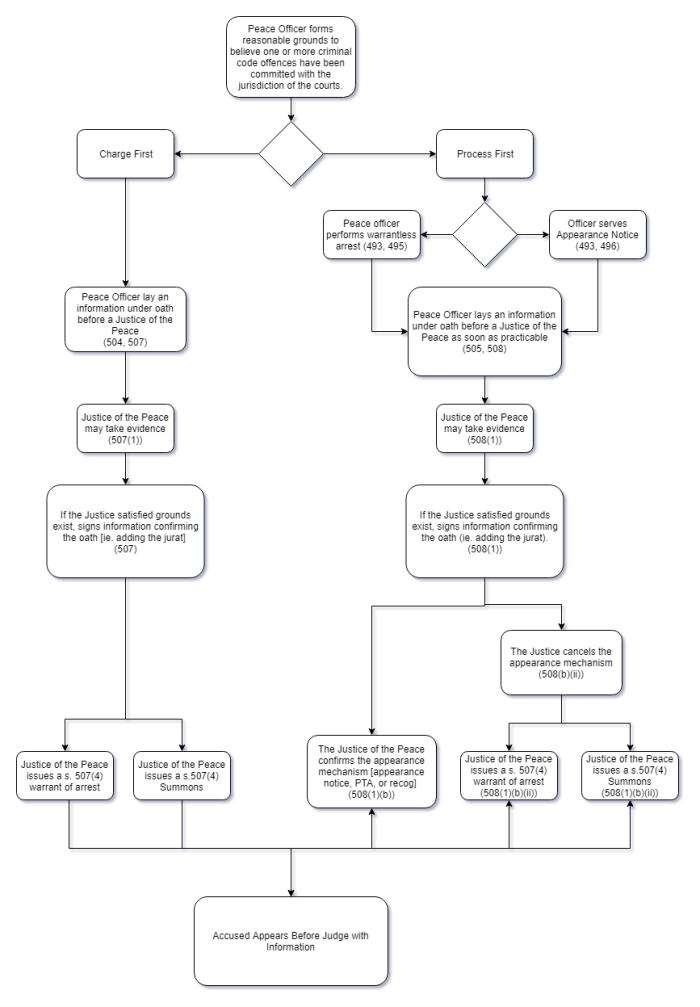« Obliger l'accusé à se présenter au tribunal » : différence entre les versions
Page créée avec « {{en|Compelling_the_Accused_to_Attend_Court}} » |
Aucun résumé des modifications |
||
| Ligne 1 : | Ligne 1 : | ||
{{en|Compelling_the_Accused_to_Attend_Court}} | {{en|Compelling_the_Accused_to_Attend_Court}} | ||
{{Fr|Obliger_l%27accusé_à_se_présenter_au_tribunal}} | |||
{{Currency2|January|2016}} | |||
{{LevelZero}} | |||
{{HeaderRelease}} | |||
==Introduction== | |||
{{seealso|Warrantless Arrests|Warrant Arrests}} | |||
A person can be compelled to attend court to face criminal charges in several ways. It starts with the police. They investigate a crime and at some point they suspect an individual is responsible. | |||
The police start by doing one of three things: | |||
# serve an appearance notice on the accused; | |||
# arrest the accused; or | |||
# lay a charge and issue a warrant or summons | |||
These are not mutually exclusive actions but rather first steps. | |||
Where the person is given an appearance notice, they are simply served with a document directing them to attend court. | |||
Where the person is arrested first, the police will decide whether to lay a charge. If a charge will be layed the police can do one of the following: | |||
# hold him for court | |||
# release him using a summons, Appearance Notice, Promise to Appear (with or without an undertaking), or Recognizance (with or without an undertaking) | |||
If they are held for court, the issue of release will be left to the judge to determine. | |||
Where the charge is layed first, the warrant or summons gives authority to the police to locate the individual for the purpose of arresting them to serving them with notice to attend court. | |||
==Topics== | |||
* [[Compelling Attendance by Accused Without Arrest]] | |||
* [[Warrantless Arrests]] and [[Warrant Arrests]] | |||
* [[Laying of an Information]], [[Issuing Process]] and [[Informations and Indictments]]: At some point after the initial arrest and before the first appearance for arraignment, the peace officer is expected to prepare an Information and swear the information before a justice of the peace. The officer will give sworn evidence that they had reasonable ground to believe that the offence had been committed by the accused. This can be done at any time prior to the first appearance for arraignment so long as it is within the time limit for the offence (6 months if summary offence). | |||
* [[Release by Police]] | |||
* Compelling Attendance Out of Custody | |||
** [[Accused Arrest Warrants for Failing to Attend Court]] | |||
* [[Judicial Interim Release]]: If the peace officer does not release the accused, then under s. 503 they must present the accused before a justice within 24 hours to consider whether to release the accused under s. 515. | |||
* [[Procuring the Attendance of a Prisoner]] | |||
==Flow Chart== | |||
[[File:Charging flow chart.png|700px]] | |||
==See Also== | |||
* [[Compelling Attendance of Witnesses]] | |||
Version du 20 juin 2024 à 21:55
| Ang |
| Cette page a été mise à jour ou révisée de manière substantielle pour la dernière fois January 2016. (Rev. # 2339) |
| n.b.: Cette page est expérimentale. Si vous repérez une grammaire ou un texte anglais clairement incorrect, veuillez m'en informer à [email protected] et je le corrigerai dès que possible. |
Introduction
A person can be compelled to attend court to face criminal charges in several ways. It starts with the police. They investigate a crime and at some point they suspect an individual is responsible.
The police start by doing one of three things:
- serve an appearance notice on the accused;
- arrest the accused; or
- lay a charge and issue a warrant or summons
These are not mutually exclusive actions but rather first steps.
Where the person is given an appearance notice, they are simply served with a document directing them to attend court.
Where the person is arrested first, the police will decide whether to lay a charge. If a charge will be layed the police can do one of the following:
- hold him for court
- release him using a summons, Appearance Notice, Promise to Appear (with or without an undertaking), or Recognizance (with or without an undertaking)
If they are held for court, the issue of release will be left to the judge to determine.
Where the charge is layed first, the warrant or summons gives authority to the police to locate the individual for the purpose of arresting them to serving them with notice to attend court.
Topics
- Compelling Attendance by Accused Without Arrest
- Warrantless Arrests and Warrant Arrests
- Laying of an Information, Issuing Process and Informations and Indictments: At some point after the initial arrest and before the first appearance for arraignment, the peace officer is expected to prepare an Information and swear the information before a justice of the peace. The officer will give sworn evidence that they had reasonable ground to believe that the offence had been committed by the accused. This can be done at any time prior to the first appearance for arraignment so long as it is within the time limit for the offence (6 months if summary offence).
- Release by Police
- Compelling Attendance Out of Custody
- Judicial Interim Release: If the peace officer does not release the accused, then under s. 503 they must present the accused before a justice within 24 hours to consider whether to release the accused under s. 515.
- Procuring the Attendance of a Prisoner

